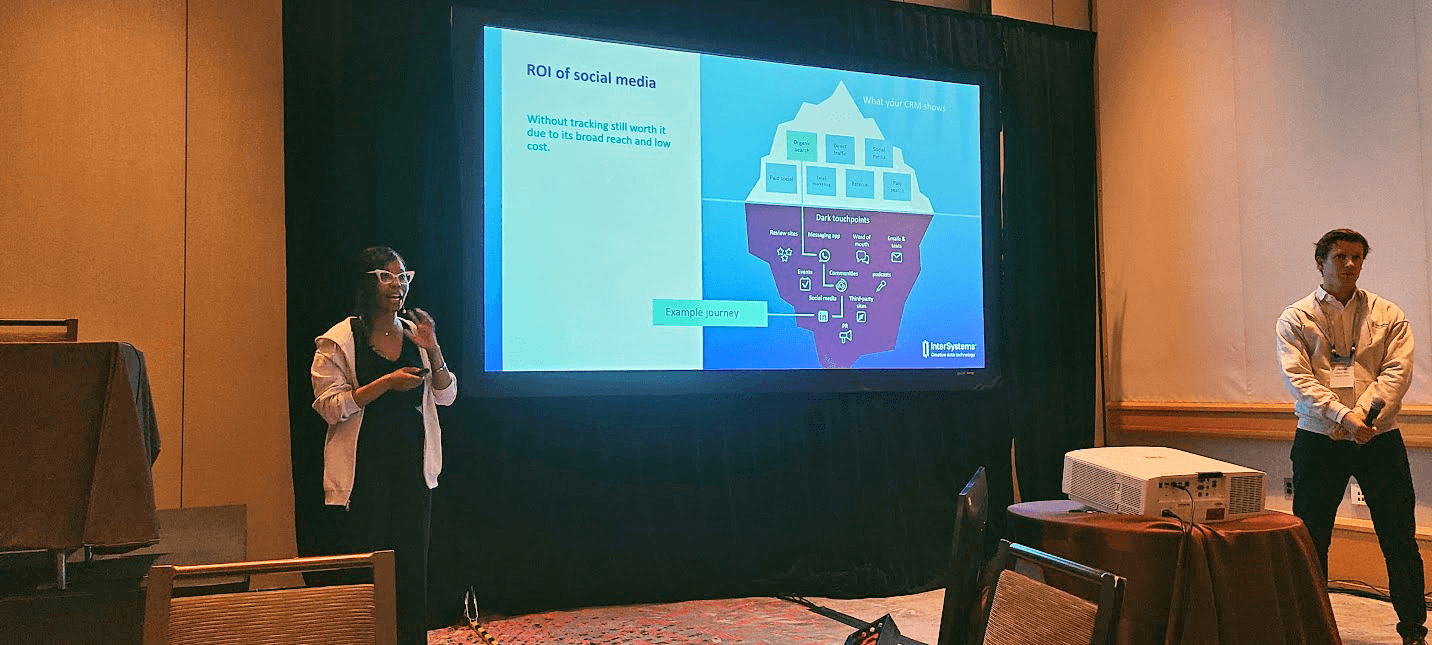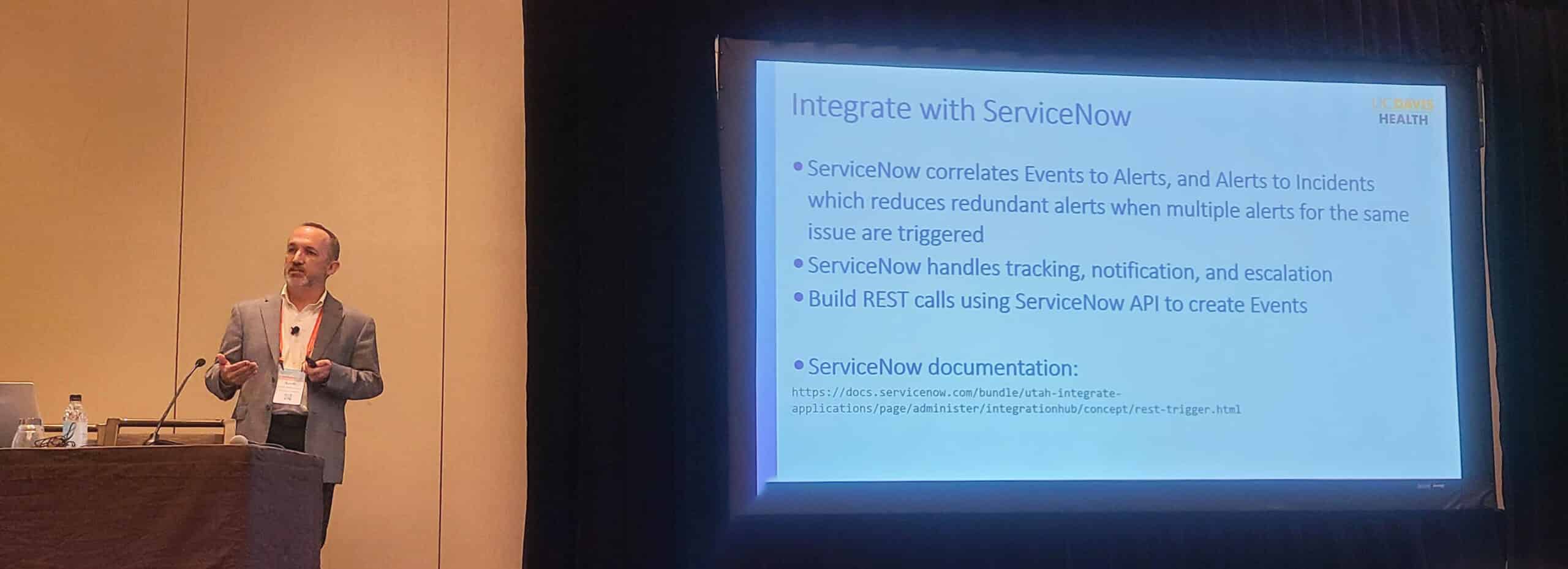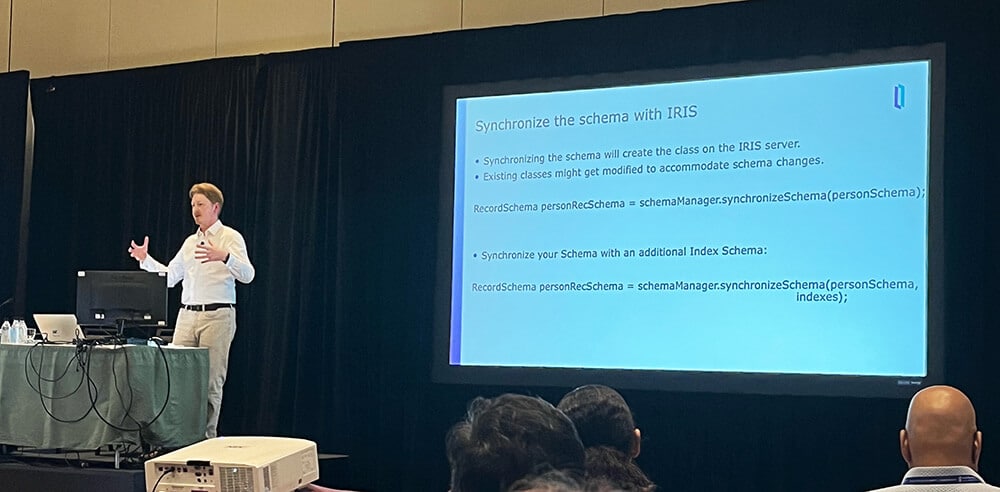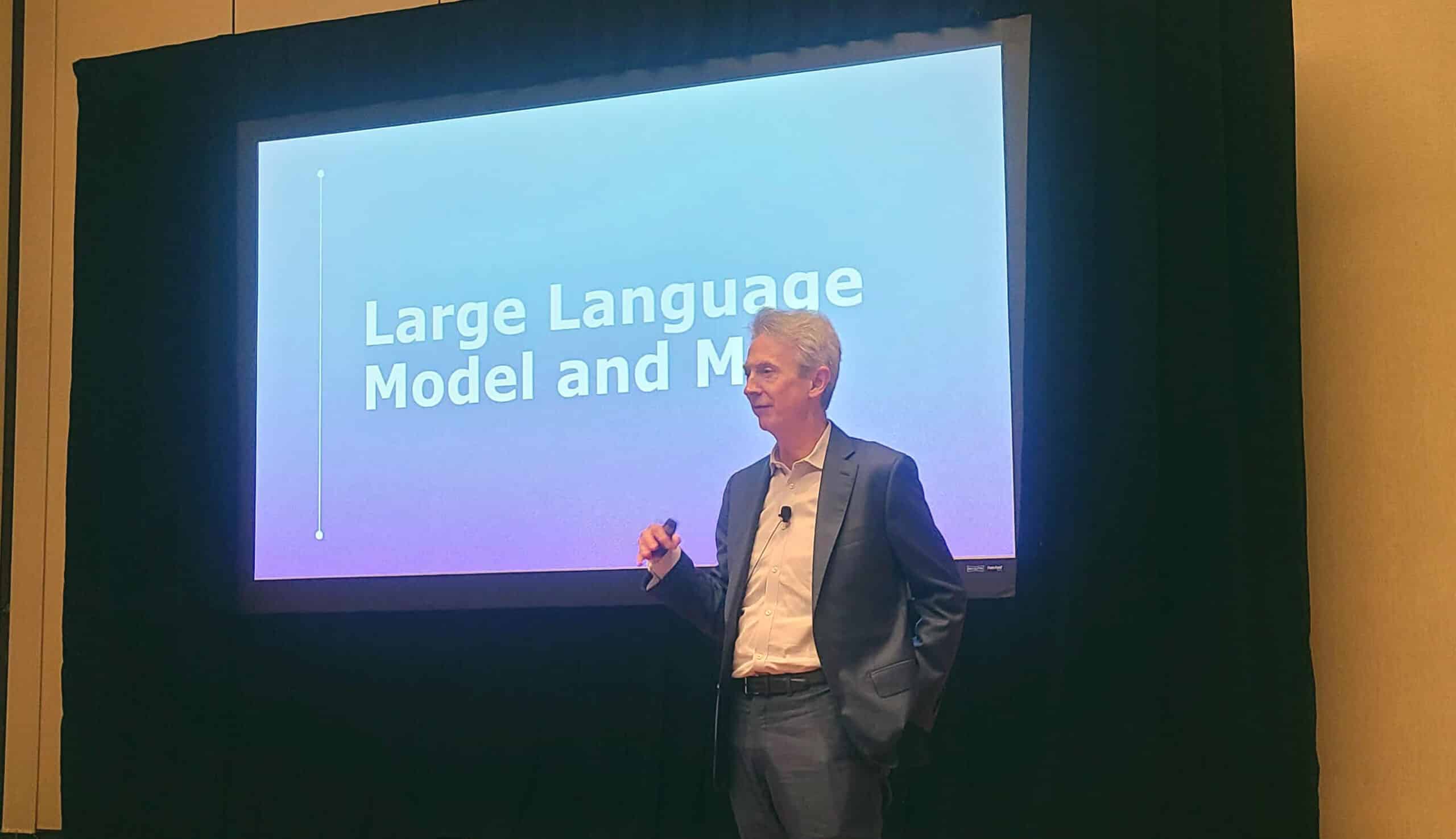| Part One | Part Two |
|---|

InterSystems Global Summit is the premier event for the InterSystems technology community. We attended this year’s 2023 conference in Hollywood, Florida and are pleased to provide highlights from some of our favorite sessions. Part 2!
Stay Ahead or Fall Behind: Use Social Media to Promote Yourself, Your Work & Your Company

- Date: Sunday, June 4, 2023
- Presenters:
- Clemence Sop, Head of Marketing Innovation, InterSystems
- Jesse Bak, LinkedIn Strategy Consultant, TextJesse
- Overview: The InterSystems social team leads provide an insightful look into how Intersystems is leveraging social media, in particular, LinkedIn, to grow their reach, credibility, and sales outreach in a meaningful way.
Clemence Sop led the social media workshop by taking the room on a journey through the benefits and influence of thought leadership in social media channels and how that can translate positively to vendor selection and sales. She also touched on how developers are leveraging social media now and trends for the future, namely audio-based social media, augmented reality, and the adoption of AI in social media.
Sop and Jesse Bak also talked about how InterSystems uses social media across various areas, such as thought leadership, social selling, recruitment, employer branding, community building, corporate brand awareness, and lead generation. They shared a deep dive into social selling and explained how to best approach this and tailor it for each of our business use cases.

Sop then highlighted the intentional work that InterSystems has done and continues to do to elevate John Paladino, Michael Amous, and Andries Demont as thought leaders, starting with the newsletter and focusing on strong customer service.
After a short break, the workshop portion of the session commenced, and the group learned about writing effective headlines and navigating the LinkedIn secret formula to create the perfect post while gaining insights into the LinkedIn algorithm.
Introducing HealthShare Analytic Solution Builder

- Date: Monday, June 5, 2023
- Presenter: Jonathan Wald, Clinical Product Manager, InterSystems
- Overview: A Proof-of-Concept self-service, template-driven solution to simplify analytics for users.
Jonathan Wald, Clinical Product Manager, Health Insight Solutions, presented a proof of concept development of a self-service, template-driven analytics tool. For various reasons, SQL remains the go-to tool for most analytics work; and yet, most SQL queries used in analytic research are complex, difficult to construct, and run rather slowly.
The analyst’s workflow typically begins with a set of business rules that describe the problem. These are converted into logical steps on patient data from which the analyst creates a data model. The model is coded and tested, and its run on production data creates an output 2-D table (from which a report with visualizing tools is usually produced).
As an example, Wald used diabetes measures for payers and providers (HEDIS), asking which patients with diabetes have high or missing HbA1c. In order to answer, first, the data is constrained by age, insurance gap, excluding confounding conditions, and number of visits. Only then can we start asking if HbA1c > 9%, for instance. The idea is to create a template wizard to break the problem into blocks and steps. Each constraint represents a block with any of these steps: Populate – load data; Derive – calculate something; Filter – exclude data; ForEach – work each item; Export – create output table. Each step mimics a SQL operation but instead uses JSON schema and FirePath.
The analysis has many advantages:
- Blocks and steps are movable and reusable
- Steps are easily modified and multi-thread-ready
- Design, troubleshooting, and testing are easier
- Blocks can run for all patients or a single patient
The next steps in 2023 are completing POCs, developing and testing UI, and confirming modeling capabilities, data shaping requirements, and performance benchmarks.
Embedded Source Control with Git & Containers

- Date: Monday, June 5, 2023
- Presenter: Pravin Barton, Senior Software Developer, InterSystems
- Overview: In this session, Pravin Barton explores the use of git-source-control, an open-source tool managed by InterSystems that seamlessly integrates with VS Code and IRIS.
Source control is mandatory for software developers in the 21st century. InterSystems has many options for source control in IRIS, including Perforce, tools available on the InterSystems Open Exchange, or even the opportunity to create your own solution.
Here, Pravin Barton shared git-source-control, a git-based source control solution that integrates with IRIS and even offers additional functionality.
git-source-control is configured just like any other source control solution and is configured with a web-based GUI. Its GIT support includes fully fleshed-out GIT branching.
git-source-control allows developers to create folder mappings for their GIT repository, and developers can edit code on the IRIS server just like they did with Studio. The on-save hooks in git-source-control will push the exported classes to the file system in the class (or file) mapped directories configured.
This tool also adds a concurrency layer to IRIS, which otherwise does not exist.
Finally, the custom pull event handler baked into git-source-control allows developers to do all sorts of things, like deploy code, execute config tasks, and even use any package management tool (including IPM).
Introducing InterSystems Supply Chain Orchestrator

- Date: Monday, June 5, 2023
- Presenters:
- Ming Zhou, Head of Supply Chair Strategy, InterSystems
- Annie Tong, Sales Engineer, InterSystems
- Overview: This presentation showcased the next-generation data platform and key supply chain services for building supply chain solutions with real-time intelligence that drives predictive and prescriptive actionable insights throughout the supply chain.
InterSystems IRIS for Supply Chain builds on top of InterSystems IRIS Data Platform, where a platform is provided to integrate with and consume data from disparate systems and store this in InterSystems’ Supply Chain Data Model. The data model can be extended to meet client-specific needs.
Once the data is loaded, a framework provides business intelligence and machine learning. KPIs can be defined, and there is seamless integration with external BI & ML tools. The goal is to supply a “smart data fabric platform” for analytics, AI/ML, and actionable insights. Several cloud services will be offered in this new platform, e.g., track and trace and forecasting services. A service marketplace will be available where InterSystems-supplied community services will be available along with community-developed services.
How to Customize the InterSystems IRIS for Health FHIR Repository

- Date: Monday, June 5, 2023
- Presenter: Theo Stolker, Senior Sales Engineer – IRIS for Health, InterSystems
- Overview: Theo Stolker demonstrates how to customize an IRIS for Health FHIR repository to satisfy various requirements, such as maintaining referential integrity and enforcing ID uniqueness.
FHIR is designed such that the base spec takes care of the “80%” Pareto principle use cases. In the event that your use case falls into the “20%”, FHIR provides facilities to customize the standard to your needs. Theo Stolker’s demonstration involved enabling several Intersystems FHIR classes to customize a FHIR endpoint with some typical use cases.
When customizing a FHIR repository, you can use the FHIR Interop service/operation to customize processing in a production; however, a faster option is to directly modify the FHIR Interaction Strategy, which is the methods the endpoint uses to interact with the underlying FHIR database.
The FHIR repository is comprised of four databases:
- the **.R.Rsrc database to store the ‘current’ resources
- the **.V.RsrcVer to store the previous versions of resources
- the **.S.Rsrc and **.S.{resourceType} to store the common search parameters/search parameters per resource type
The FHIR endpoint interactions with the databases are defined by HS.FHIRServer.Json.RepoManager/InteractionsStrategy/Interactions/Resource/ResourceVer, all of which can be subclassed and customized depending on the use case. NOTE: The customization to the InteractionsStrategy must be defined before the endpoint has been created because it can only be changed at instantiation.
The demonstration consisted of enforcing globally unique resource IDs, performing post-processing, including populating *Resource.text for references/ordering resource properties, and enforcing referential integrity for reference properties.
Advanced Operational Monitoring & Alerting at UC Davis & Integration with Service Now

- Date: Tuesday, June 6, 2023
- Presenters:
- Scott Nathanson, Senior Interface Programmer, UC Davis Health
- Kevin Kindschuh, Senior Sales Engineer, InterSystems
- Overview: Scott Nathanson from UC Davis discusses the implementation of a centralized management system for alerting and incident management, including features such as integrating with a ticketing system, suppressing alerts during known downtimes, and generating reports for monitoring purposes.
In this presentation, Scott Nathanson discussed his experience working with innovative additions to the monitoring infrastructure. These additions allowed for calendaring, latency configuration changes, and integration with the Incident Management application. By merging alerts from multiple namespaces into a new namespace for Alerts, using the altering settings in IRIS, and implementing analysis configuration, Nathanson highlighted how the monitoring system has reached a new level of efficiency. He emphasized the importance of centralized management, reducing alert noise, and maintaining self-healing capabilities. Additionally, Nathanson shared insights on utilizing the existing ticketing system, ServiceNow, for incident tracking and event correlation and how they generate reports to gain visibility into potential issues and upcoming problems.

The presentation further delved into various features and enhancements implemented in the monitoring system. Nathanson explained the use of work groups and consistent naming conventions to streamline alert management, highlighting the significance of built-in triggers, such as queue wait time and inactivity timeout, for effective monitoring, as well as the usefulness of customizing actions, retry intervals, and failure timeouts to handle errors and self-fixing mechanisms. Additionally, the monitoring system integrates with ServiceNow, enabling the correlation of events, alerts, and incidents.
Nathanson also highlighted the ability to set alert suppression on known holidays, after hours, and during known downtimes. Future enhancements will include the ability for the system to recognize and generate an “All Clear” message to let the team know the alert has cleared.
System Index: A New Pipeline for Data in the Unified Care Record

- Date: Tuesday, June 6, 2023
- Presenters:
- Arny Epstein, Director of Development, HealthCare Products, InterSystems
- Shariqah Hossain, Senior Software Developer, InterSystems
- Matthew Spielman, Senior Manager, Product Management, InterSystems
- Overview: A deep-dive into System Index, the new architecture for HealthShare clinical data tracking that will enable faster data aggregation, reduce data duplication, and allow for better system scalability.
System Index is a new HealthShare core feature that is designed to allow rapid location and retrieval of SDA streamlets across a federation. This feature provides a number of benefits, including improved performance, reduced cost, and increased deployment flexibility.
Under the previous model, data retrieval from Edges required querying the Registry to determine metadata/consent; additionally, the actual data retrieval process involved queries made to multiple Edges, some of which did not contain the data to be retrieved.
Under the new model, the SysIndex becomes the one-stop-shop to determine how and where to retrieve data. The SysIndex stores streamlet metadata, pre-calculates consent, and directs fetch requests specifically to the Edges that contain the data. Additionally, the SysIndex detects duplicates and effectively de-duplicates streamlets as the metadata is stored.
SysIndex’s underlying architecture relies on an Edge Watcher, which runs multiple Edge Pollers to poll each Edge for changes. When changes are detected, SysIndex stores the metadata/updates locally. The key component interacting with external clients is the search handler, which returns streamlet metadata based on search criteria. For data retrieval, the feeder service uses a pipeline controller to dynamically adjust the number of session pollers and session feeders to enforce a maximum buffer size. Data retrieval can operate in two different modes: fetch mode and streaming mode. Finally, SysIndex can be configured through the Management Portal UI, which also allows monitoring of the entire data pipeline from the Edge> SysIndex > SysIndex Client.
Shariqah Hossain demonstrated where SysIndex was connected to multiple Health Insight clients. A backload of metadata into SysIndex was performed, after which the data was fed into Health Insight client #1. Health Insight client #2 was started, and Health Insight client #1 was stopped, demonstrating that there was no pileup of data in a feeder gateway.
SysIndex is generally available as of HSUCR 2022.2.
Language Connectivity: New & Next

- Date: Tuesday, June 6, 2023
- Presenter: Stefan Wittmann, Product Manager, InterSystems
- Overview: Learn the latest updates on how InterSystems manages connectivity libraries for Java, .NET, Python, and more.
Thousands of people develop against IRIS daily, but not all use ObjectScript or even Caché Macros. Some use Java, .NET, Node.js, or Python. In this session, we started by learning the latest steps in how InterSystems manages these connectivity libraries.
One of the first things brought up by Stefan Wittmann is that various libraries hit LTS or Deprecation at different times and frequencies. As such, tying version-specific connectivity libraries to IRIS releases is problematic. To resolve this, InterSystems has separated the language connectivity libraries from the IRIS install and published them to local repositories within InterSystems. Then, when a new build of IRIS is created, they package the latest builds of the latest connectivity libraries to go with it. This packaging allows these connectivity libraries to be managed independently of IRIS builds.

After this, Wittmann walked us through the use of Java Persister, a new tool used for high-throughput data intake. This Persister is very flexible and can be used to define Schemas within IRIS. The slides for this half of the session contain all of the information you need, as well as the additional dedicated Java Persister presentation also offered during Global Summit ’23.
Persist!
Triage Patient Portal Messages Using ChatGPT

- Date: Tuesday, June 6, 2023
- Presenters:
- Qi Li, MD, Director of Product Innovation, InterSystems
- Don Woodlock, Head of Global Healthcare Solutions, InterSystems
- Meredith Staszak, Product Manager, Patient Experience, InterSystems
- Overview: The InterSystems team discussed the challenges of managing a high volume of medical-related patient messages and using machine learning models to classify urgent messages.
The session highlighted the issue of managing many medical-related messages, particularly during the pandemic, with hospitals receiving thousands of messages per month. The volume of messages poses a significant challenge for healthcare providers who need to process and prioritize them, and using machine learning models to classify urgent messages automatically is one solution. Training these models using pre-trained language models and fine-tuning them with labeled data makes it possible to predict the probability of a message being urgent. The model’s performance is evaluated based on recall and precision metrics and compared to a string search algorithm. The results show that the machine learning model outperforms the string search approach in identifying urgent messages, with a recall of 8 out of 36 urgent messages compared to 6 for the string search. The session also emphasized the importance of determining an appropriate threshold for classifying messages as urgent to balance between correctly identifying urgent messages and avoiding false positives.

The session further explored the validation and performance of the machine-learning model. It discussed the process of training the model using a set of labeled urgent messages and evaluating its performance against a human expert. The model achieves a performance comparable to a human expert, with similar levels of identification of urgent messages. There is still more validation work to be done, but overall, the machine learning model shows promise in effectively classifying urgent messages and improving workflow efficiency.
Finally, the session also touched on the broader goal of enhancing patient experience through better management of urgent messages. By prioritizing urgent messages, patients can receive faster responses and improved care. Additional use cases beyond urgent message management are being explored to enhance user experience and ultimately benefit patients.
| Part One | Part Two |
|---|
Thank you for joining us for this year’s InterSystems Global Summit recap. See you next year!
J2 Interactive is an award-winning software development and IT consulting firm specializing in customized solutions for hospitals, labs, research institutions, and health information exchanges.
Our approach to design and development is rooted in a fundamental belief that systems succeed or fail based on how well they serve the people who depend upon them. Drop us a line to learn more.



